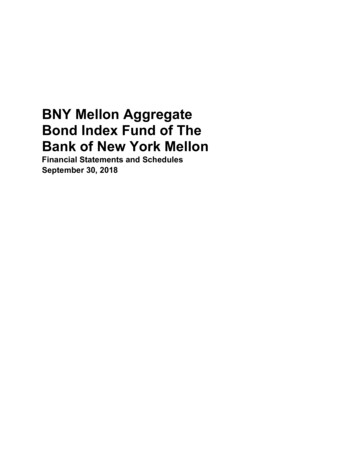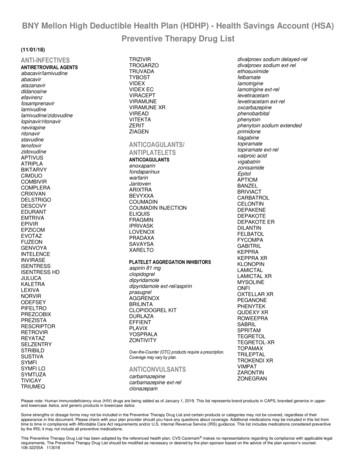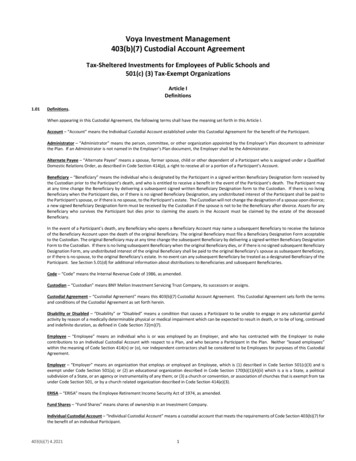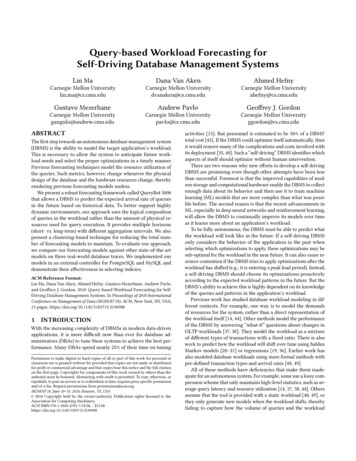
Transcription
BNY MELLON INVESTMENT SERVICING TRUST COMPANYSupplement to the Traditional and Roth Individual Retirement Account (IRA)Disclosure StatementIMPORTANT CHANGES TO THE RULES GOVERNING INDIRECT (60‐DAY) ROLLOVERS BETWEEN IRA ACCOUNTSBeginning January 1, 2015, there will be a new restriction placed on indirect (60‐day) IRA‐to‐IRA rollovers. An IRA participant will be allowed only one rolloveracross all IRAs (Traditional, Rollover, Roth, SEP, SARSEP and SIMPLE IRAs) in aggregate that a taxpayer owns in any 12‐month or 365‐day period. As an alternative, aparticipant can make an unlimited number of trustee‐to‐trustee transfers where the proceeds are delivered directly to the receiving financial institution, successorcustodian or trustee. You must contact the receiving institution to initiate a trustee‐to‐trustee transfer. For more information please visit the Internal RevenueService’s web site www.irs.gov using the search term “IRA One‐Rollover‐Per‐Year Rule”, “Announcement 2014‐15 or “Announcement 2014‐32”.2015 IRA CONTRIBUTION LIMITS FOR TRADITIONAL AND ROTH IRAThe maximum allowable contribution to your IRAs (deductible, non‐deductible, and Roth) for the tax year is the lesser of (a) 5,500 or (b) 100% of yourcompensation or earnings from self‐employment. For those who have attained or will attain the age of 50 before the close of the taxable year, the annual IRAcontribution limit is increased by 1,000 (total of 6,500 for 2015). Any contribution made to your IRA will be treated as a current year contribution recorded in theyear it is received, unless the contribution is made between January 1 and April 15, 2015, and you have identified the contribution as a prior year contribution.Please read the Combined IRA Disclosure Statement carefully or consult IRS Publication 590 for IRA eligibility requirements and contribution restrictions.2015 TRADITIONAL IRA INCOME TAX DEDUCTION:Your contribution to a traditional IRA may be deductible on your federal income tax return. However, there is a phase‐out of the IRA deduction if you are an activeparticipant in an employer‐sponsored retirement plan. The IRA deduction is reduced proportionately as modified adjusted gross income increases. If you are not anactive participant in an employer‐sponsored retirement plan, there is a phase‐out of the IRA deduction based on income and, if married, based on whether or notyour spouse is covered by a workplace retirement plan. Please consult IRS Publication 590 for calculating your deductible contribution as it pertains to individualincome and employer‐sponsored retirement plan circumstances. Your contributions in excess of the permitted deduction will be considered non‐deductiblecontributions.DEDUCTION LIMIT ‐ Effect of Modified AGI on Deduction – Covered by a Retirement Plan at WorkTAX YEAR 2015Full deduction ifmodified AGI is:Partial deduction ifmodified AGI is:No deduction ifmodified AGI is:Single Filers or Head of Household 61,000 or lessMore than 61,000but less than 71,000 71,000 or moreMarried ‐ filing jointly or Qualified Widow(er) 98,000 or lessMore than 98,000but less than 118,000 118,000 or moreMarried ‐ filing separatelyN/ALess than 10,000 10,000 or moreDEDUCTION LIMIT ‐ Effect of Modified AGI on Deduction – You are NOT Covered by a Retirement Plan at Work (Spousal Coverage Considered)TAX YEAR 2015Full deduction ifmodified AGI is:Partial deduction ifmodified AGI is:No deduction ifAGI is:Married ‐ filing jointly ‐ spouse coveredat work 183,000 or lessMore than 183,000but less than 193,000 193,000 or moreMarried ‐ filing separately ‐ spouse coveredat workN/ALess than 10,000 10,000 or more2015 ROTH IRA CONTRIBUTION ELIGIBILITY:For 2015, your Roth IRA contribution limit is reduced (phased out) based on your modified AGI as follows:TAX YEAR 2015Full contribution ifmodified AGI is:Partial contribution ifmodified AGI is:No contribution ifAGI is:Married ‐ filing jointly or Qualified Widow(er)Less than 183,000At least 183,000but less than 193,000 193,000 or moreMarried ‐ filing separatelyN/Aless than 10,000 10,000 or moreSingle, Head of Household or Married ‐ filingseparately and you did not live with yourspouse at any time during the yearLess than 116,000At least 116,000but less than 131,000 131,000 or moreThese limits may be adjusted from time to time by the Internal Revenue Service, please refer to Publication 590 for current year limits.
UPCOMING CHANGES TO IRS PUBLICATION 590:In September of 2014, the IRS updated Publication 590 to notify taxpayers of their intention to split Publication 590 into two separate documents (the note islocated below the table of contents).“Note. After 2013, Publication 590 will be split into two separate publications as follows.Publication 590‐A, will focus on contributions to traditional IRAs as well as Roth IRAs. This publication will include the rules for rollover andconversion contributions.Publication 590‐B, will focus on distributions from traditional IRAs as well as Roth IRAs. This publication will include the rules for requiredminimum distributions and IRA beneficiaries.”QUALIFIED CHARITABLE DISTRIBUTION (“QCD”) PROVISION – EXPIRED ON DECEMBER 31, 2014QCDs allowed certain taxpayers who were age 70½ or older to transfer funds from their IRA to an eligible charitable organization; however, the provision expiredon December 31, 2014. For more information about QCDs, or for future legislative updates on efforts to further extend the provision or make it permanent, checkIRS Publication 590 or the IRS website www.irs.gov under the term “QCD” or “Charitable Donations from IRAs”.SPOUSAL PROVISIONS FOR SAME SEX COUPLESEffective September 16, 2013, same‐sex couples who are legally or lawfully married in a state or country that recognizes same‐sex marriage will be treated as a“spouse” for federal tax purposes. The IRS will look to state or foreign law to validate the marriage. Same‐sex couples who are in a civil union or domesticpartnership will not be afforded the same federal tax treatment.BENEFICIARY DESIGNATIONSPer Stirpes Beneficiary Designations: The Custodian shall accept as complete and accurate all written instructions provided in good order by the estate/executorwith regard to the identification of the beneficiaries and the allocations thereto.In the event of your death, the balance of your custodial account shall be paid to the primary beneficiaries who survive you in equal shares (or in the specifiedshares, if indicated). If none of the primary beneficiaries survive you, the balance of your account shall be paid to the contingent beneficiaries who survive you inequal shares (or in the specified shares, if indicated). If you name multiple primary beneficiaries and a beneficiary does not survive you, such interest is terminatedand that percentage will be divided proportionately among the remaining primary beneficiaries. Similarly, unless you have specified otherwise, if no primarybeneficiary survives you and you have named multiple contingent beneficiaries and a beneficiary does not survive you, such interest is terminated and thatpercentage will be divided proportionately among the remaining contingent beneficiaries.You may change your beneficiaries at any time by giving written notice to the Custodian. If you do not designate a beneficiary, or if all designated beneficiariespredecease you, your surviving spouse will become the beneficiary of your IRA. If you do not have a surviving spouse at the time of your death, your estate willbecome the beneficiary of your IRA. If a trust is designated as a beneficiary, you must provide both the date of the trust and the name(s) of the trustee(s).SPOUSAL BENEFICIARY DESIGNATION IN THE EVENT OF DIVORCEIn the event of a divorce or legal separation, the Custodian will not automatically remove the former spouse as the designated beneficiary without courtappointment. If your life circumstances have changed, we suggest you submit an IRA Beneficiary Designation Form. The current beneficiary designation on file withthe Custodian will be deemed valid and in full force until such date as the Custodian receives a signed IRA Beneficiary Designation Form, in good order.CIRA2
BRIDGEWAY FUNDSINDIVIDUAL RETIREMENT ACCOUNT (IRA)TRADITIONAL IRASEP IRAROTH IRA
TABLE OF CONTENTSCOMBINED DISCLOSURE STATEMENTTRADITIONAL INDIVIDUAL RETIREMENT ACCOUNT DISCLOSUREROTH INDIVIDUAL RETIREMENT ACCOUNT DISCLOSURETRADITIONAL IRA CUSTODIAL ACCOUNT AGREEMENTROTH IRA CUSTODIAL ACCOUNT AGREEMENTAPPLICATION AND ADOPTION AGREEMENT INSTRUCTIONSAPPLICATION AND ADOPTION AGREEMENTCERTIFICATION OF ROLLOVER ASSETSTRANSFER OF ASSETS / DIRECT ROLLOVER FORMPRIVACY POLICY36811162021252628References to the "Custodian" mean BNY Mellon Investment Servicing Trust Company.CIRA2
TRADITIONAL and ROTH INDIVIDUAL RETIREMENT ACCOUNT (IRA)COMBINED DISCLOSURE STATEMENTThe following information is the disclosure statement required by federal tax regulations. You should read this Disclosure Statement, the Custodial AccountAgreement and the prospectuses for the mutual funds in which your Individual Retirement Account (“IRA”) contributions will be invested. The rules governing IRAsare subject to change. You should consult Internal Revenue Service (“IRS”) Publication 590 or the IRS web site www.irs.gov for updated rules and requirements.IMPORTANT INFORMATION ABOUT U.S. GOVERNMENT REQUIREMENTS THAT MAY AFFECT YOUR ACCOUNTBNY Mellon Investment Servicing Trust Company (“BNY Mellon”, “we”, or “us”), provides custodial and administrative services for your retirement or savingsaccount. As a result of this role, persons who open a retirement or savings account are considered ‘customers’ of BNY Mellon (“you” or “your”).To help the U.S. Government fight the funding of terrorism and money laundering activities, Federal law requires BNY Mellon, as a financial institution, to obtain,verify, and record information that identifies each person who opens an account. All accounts we open are opened on a conditional basis – conditioned on ourability to verify your identity in accordance with Federal law.When establishing an account, you are required to provide your full legal name, address, government issued identification number (e.g. social security number),date of birth, and other information within your account‐opening application that will allow us to identify you. We may also request a copy of your driver’s licenseor other identifying documents and may consult third‐party databases to help verify your identity. If the account you are opening will be registered in the name ofa beneficiary, trust, or estate or charity, we may require additional identifying documentation.If you fail to provide any requested identifying information or documentation when opening your account, your new account application may be rejected.If we open your account, and you subsequently fail to provide all identification materials we request or if we are subsequently unable to adequately verify youridentity as required by U.S. Government regulations, we reserve the right to take any one or more of the following actions: We may place restrictions on your account which block all purchase transactions and we may place additional restrictions on your account blockingother transactional activities if we determine such additional restrictions are appropriate under Federal law or regulation. We may close your account, sell (i.e., "liquidate") the assets in your account in the prevailing market at the time, and send you a check representing thecash proceeds of your account. This distribution will be reported to the Internal Revenue Service and may result in unfavorable consequences to youunder Federal and state tax laws.You May Incur Losses. Despite being opened as a conditional account, your account will be invested as you instruct and you will be subject to all market risksduring the period between account opening and any liquidation necessitated by your failure to furnish requested identifying information or by an inability toadequately verify your identity. You may also be subject to additional market risks if the additional transactional restrictions discussed above are placed on youraccount. In addition, the closing of your account may subject you to fees and charges imposed by a sponsor, issuer, depository or other person or entity associatedwith one or more of the assets in which you are invested, and any sales charges you may have paid in connection with your purchases will not be refunded.You Assume All Responsibility For These Losses. BNY Mellon expressly disclaims any responsibility or liability for losses you incur as a result of your failure tofurnish identification materials we request, including investment losses and any other loss or damage (including but not limited to lost opportunities and adversetax consequences). If you proceed with the account opening process, you accept all risks of loss resulting from any failure of yours to furnish the identificationmaterials we request or from a subsequent inability to adequately verify your identity in accordance with Federal law or regulation.STATE UNCLAIMED PROPERTY LAW DISCLOSUREThe assets in your custodial account are subject to state unclaimed property laws which provide that if no activity occurs in your account within the time periodspecified by the particular state law, your assets must be transferred to the appropriate state. We are required by law to advise you that your assets may betransferred to an appropriate state in compliance with these state laws.REVOCATION OF YOUR IRAYou have the right to revoke your IRA and receive the entire amount of your initial investment by notifying the Custodian in writing within seven (7) days ofestablishing your IRA (account open date). If you revoke your IRA within seven days, you are entitled to a return of the entire amount contributed, withoutadjustment for such items as sales commissions, administrative expenses, or fluctuations in market value. If you decide to revoke your IRA, notice should bedelivered or mailed to the address listed in the application instructions. This notice should be signed by you and include the following:1.The date.2.A statement that you elect to revoke your IRA.3.Your IRA account number.4.The date your IRA was established.5.Your signature and your name printed or typed.Mailed notice will be deemed given on the date that it is postmarked, if it is properly addressed and deposited either in the United States mail, first class postageprepaid, or with an IRS approved overnight service. This means that when you mail your notice, it must be postmarked on or before the seventh day after your IRAwas opened. A revoked IRA will be reported to the IRS and the Depositor on IRS Forms 1099‐R and 5498.CONTRIBUTIONSFor 2015, the maximum allowable contribution to your individual retirement accounts (deductible, non‐deductible, and Roth) is the lesser of (a) 5,500 or (b) 100%of your compensation or earnings from self‐employment. If you are submitting a prior year contribution, the limit was set at 5,500.Age 50 or above catch‐up contributions – For those who have attained the age of 50 before the close of the taxable year, the annual IRA contribution limit isincreased by 1,000.For tax years after 2015, the above limits may be subject to Internal Revenue Service (“IRS”) cost‐of‐living adjustments, if any. Please read the Traditional and RothIndividual Retirement Account (IRA) Combined Disclosure Statement carefully or consult IRS Publication 590 or a qualified tax professional for more informationabout eligibility requirements and contribution restrictions.CIRA3
Making an IRA contribution on behalf of your spouse ‐ If you have earned compensation, are married and file a joint federal income tax return, you may make anIRA contribution on behalf of your working or nonworking spouse. The total annual contribution limit for both IRAs may not exceed the lesser of the combinedcompensation of both spouses or the annual IRA contribution limits as set forth by the IRS. Contributions made on behalf of a spouse must be made to a separateIRA account established by your spouse. More information about eligibility requirements and contribution restrictions can be found in IRS Publication 590.thAny contribution made to your IRA will be treated as a contribution for the year it is received, unless the contribution is made between January 1 and the April 15postmark deadline and you have identified the contribution as a prior year contribution. TRADITIONAL IRA CONTRIBUTION RESTRICTION ‐ You cannot make contributions to your traditional IRA for any taxable year after you attain age 70½. ROTH IRA CONTRIBUTION ‐ Contributions can continue to be made to a Roth IRA after you attain age 70½ as long as the requirements of earned income aremet.DESCRIPTION OF AVAILABLE OPTIONS FOR YOUR CONTRIBUTIONSThe assets in your custodial account will be invested in accordance with instructions communicated by you (or following your death, by your beneficiary) or by your(or following your death, your beneficiary’s) authorized agent. Account contributions may be invested in shares of one or more mutual funds made available to youin connection with this IRA account (the “Mutual Funds”), or in other investments that are eligible for investment under section 408(a) of the Internal RevenueCode and that are acceptable to the Custodian as investments under the Individual Retirement Account (IRA) Application and Adoption Agreement.Mutual Fund Investments: An investment in any of the Mutual Funds involves investment risks, including possible loss of principal. In addition, growth in the valueof your Mutual Funds is neither guaranteed nor protected due to the characteristics of a mutual fund investment. Detailed information about the shares of eachMutual Fund available to you for investment of your IRA contributions must be furnished to you in the form of a prospectus. The method for computing andallocating annual earnings is set forth in the prospectus. (See the section of each prospectus entitled "Dividends.") The prospectus also sets forth the costs andexpenses you incur by being invested in a particular Mutual Fund; such costs and expenses reduce any yield you might obtain from the Mutual Funds. (See thesection of the prospectus entitled "Expense Table" and the sections referred to therein.) For further information regarding expenses, earnings, and distributions ofa particular Mutual Fund, see that Mutual Fund's financial statements, prospectus and/or statement of additional information.In Article VIII, Section 23 of the TRADITIONAL IRA CUSTODIAL ACCOUNT AGREEMENT and Article IX, Section 23 of the ROTH IRA CUSTODIAL ACCOUNT AGREEMENT("Sections 23"), both of which constitute an important part of the APPLICATION and ADOPTION AGREEMENT, you authorize the Custodian to act in its discretionfor your benefit in situations where assets in your custodial account are liquidated and the Custodian has not received instructions from you in a timely mannerregarding the disposition of such proceeds or where the only instructions received from you cannot reasonably or practicably be carried out. For example, aMutual Fund may take actions which result in that Mutual Fund, or in your investment in that Mutual Fund, being involuntarily liquidated. The Mutual Fund or theprospectus for that Mutual Fund may direct that the proceeds of the liquidation be placed in an asset not available to you under the APPLICATION and ADOPTIONAGREEMENT or provide solely that the cash or other property resulting from the liquidation be distributed directly to shareholders. If the Custodian does notreceive timely instructions from you that it can reasonably and practicably carry out (for example, in‐kind property distributed by the Mutual Fund may not be apermissible asset for your IRA), then in both Sections 23 you authorize the Custodian to exercise its discretion in acting on your behalf, including taking such actionsas placing the proceeds in a money market mutual fund, an FDIC‐insured bank account or money market account, distributing the proceeds to you or holding theproceeds uninvested. Other examples may exist involving different liquidation circumstances and different restrictions or limitations regarding the disposition ofthe proceeds. The Custodian expressly disclaims any liability for any action taken or omitted under the authority of either Section 23, unless the Internal RevenueCode or regulations implementing the Internal Revenue Code require otherwise.BENEFICIARY DESIGNATIONSPer Stirpes Beneficiary Designations: The Custodian shall accept as complete and accurate all written instructions provided in good order by the estate/executorwith regard to the identification of the beneficiaries and the allocations thereto.In the event of your death, the balance of your custodial account shall be paid to the primary beneficiaries who survive you in equal shares (or in the specifiedshares, if indicated). If none of the primary beneficiaries survive you, the balance of your account shall be paid to the contingent beneficiaries who survive you inequal shares (or in the specified shares, if indicated). If you name multiple primary beneficiaries and a beneficiary does not survive you, such interest is terminatedand that percentage will be divided proportionately among the remaining primary beneficiaries. Similarly, unless you have specified otherwise, if no primarybeneficiary survives you and you have named multiple contingent beneficiaries and a beneficiary does not survive you, such interest is terminated and thatpercentage will be divided proportionately among the remaining contingent beneficiaries.You may change your beneficiaries at any time by giving written notice to the Custodian. If you do not designate a beneficiary, or if all designated beneficiariespredecease you, your surviving spouse will become the beneficiary of your IRA. If you do not have a surviving spouse at the time of your death, your estate willbecome the beneficiary of your IRA. If a trust is designated as a beneficiary, you must provide both the date of the trust and the name(s) of the trustee(s).Important note: the underlying beneficiaries of your trust (or estate) do not qualify for separate accounting. Separate accounting rules are described in IRSPublication 590 under the heading “Multiple individual beneficiaries”, “The separate account rules cannot be used by beneficiaries of a trust.” If your trust meets“look through trust” qualifications, the trustee shall provide the eldest beneficiary’s date of birth so the custodian can calculate the required minimum distributionamounts that will be paid to the trust under the trust’s tax ID. The Custodian will not accept beneficiary designations that vary from the provisions describedabove.SPOUSAL BENEFICIARY DESIGNATION IN THE EVENT OF DIVORCEIn the event of a divorce or legal separation, the Custodian will not automatically remove the former spouse as the designated beneficiary without courtappointment. If your life circumstances have changed, we suggest you submit an IRA Beneficiary Designation Form. The current beneficiary designation on file withthe Custodian will be deemed valid and in full force until such date as the Custodian receives a signed IRA Beneficiary Designation Form, in good order.SPOUSAL PROVISIONS FOR SAME SEX COUPLESEffective September 16, 2013, same‐sex couples who are legally or lawfully married in a state or country that recognizes same‐sex marriage will be treated as a“spouse” for federal tax purposes. The IRS will look to state or foreign law to validate the marriage. Same‐sex couples who are in a civil union or domesticpartnership will not be afforded the same federal tax treatment.CIRA4
TAX REFUND DIRECT DEPOSIT IRA CONTRIBUTIONSTaxpayers who qualify for a tax refund may elect to directly deposit their refund into their IRA account. The amount of the refund deposited to your IRA cannotexceed annual IRA limits as set forth by the Internal Revenue Service. You must contact the Custodian in advance of completing IRS Form 8888 to obtain the properrouting instructions. All tax refund contributions will be recorded as current year contributions for the year received.HEALTH SAVINGS ACCOUNT (“HSA”) FUNDING DISTRIBUTIONYou are allowed a one‐time, tax‐free transfer from an IRA (other than a SEP or SIMPLE IRA) to use toward your annual Health Savings Account (“HSA”) contribution.Eligible individuals may make an irrevocable one‐time, tax‐free “qualified HSA funding distribution” from an IRA and move it directly into an HSA, subject to strictrequirements. The HSA funding distribution must be directly transferred from the IRA custodian or trustee to the HSA custodian or trustee. The amount of thetransfer cannot exceed the maximum HSA contribution limit for the year that the amount is transferred. The deposited amount is counted toward the individual’stotal HSA annual contribution limit.NON‐SPOUSE BENEFICIARIES OF EMPLOYER PLANSEligible non‐spouse beneficiary distributions from an employer’s retirement plan can be directly rolled over into a beneficiary/inherited IRA. To accomplish thedirect rollover, the plan administrator must distribute the benefit payable to the trustee or custodian and mail it directly to the receiving institution. If thedistribution is paid directly to the non‐spouse beneficiary, a rollover will not be permitted.The beneficiary/inherited IRA account must be registered in both the non‐spouse beneficiary’s name and the decedent’s name. A non‐spouse beneficiary mayinclude a trust beneficiary that meets the special “look through” rules under the IRS regulations. Non qualified trusts, estates or charities are not eligible for thedirect rollover provision.QUALIFIED RESERVIST DISTRIBUTIONSEarly distributions paid to certain military reservists called to active duty after September 11, 2001 (“Qualified Reservist Distributions”) are eligible to be repaid toan IRA within a two‐year period after the end of active duty. This provision applies to distributions made after September 11, 2001. Repayments cannot exceed theamount of your Qualified Reservist Distributions. Repayment cannot be made after the date that is two years after your active duty period ends. The repaymentsare not treated as rollovers. For additional information refer to IRS Publication 590 under the heading “Qualified reservist repayments.”PROHIBITED TRANSACTIONSIf you or your beneficiary engages in any prohibited transaction as described in the Internal Revenue Code (IRC) Section 4975(c) (such as any sale, exchange,borrowing, or leasing of any property between you and your IRA; or any other interference with the independent status of the account), the account will lose itsexemption from tax and be treated as having been distributed to you in the tax year in which you or your beneficiary engaged in the prohibited transaction. Thedistribution may also be subject to additional penalties including a 10% penalty tax if you have not attained age 59½. See Publication 590 for further instructions oncalculating taxable gain, reporting amounts in income and prohibited transaction penalty taxes. In addition, if you or your beneficiary use (pledge) all or any part ofyour IRA as security for a loan, then the portion so pledged will be treated as if distributed to you, and will be taxable to you. Your distribution may also be subjectto a 10% penalty tax if you have not attained age 59½ during the year which you make such a pledge.FEES AND CHARGESThere is an annual custodial maintenance fee for each IRA account as set forth on the Application. The Custodian may also charge a service fee in connection withany distribution from your IRA.ESTATE TAXAmounts payable to your spouse, as your named beneficiary, may qualify for a marital tax deduction for federal estate tax purposes.INCOME TAX WITHHOLDINGThe Custodian is required to withhold federal income tax from any taxable distribution from your IRA at the rate of 10% unless you choose not to have taxwithheld. You may elect out of withholding by advising the Custodian in writing, prior to the distribution, that you do not want tax withheld from the distribution.This election may be made on any distribution request form provided by the Custodian. If you do not elect out of tax withholding, you may direct the Custodian towithhold an additional amount of tax in excess of 10%.State income tax withholding may also apply to distributions from your IRA account when federal income tax is withheld. Please contact your tax advisor or statetax authority for information about your state’s income tax withholding requirements.ADDITIONAL INFORMATIONDistributions under 10 will not be reported on IRS Form 1099‐R (as allowed under IRS regulations). However, you must still report these distributions to the IRS onyour Form 1040 (as well as other forms that may be required to properly file your tax return).For more detailed information, you may obtain IRS Publication 590, Individual Retirement Arrangements (IRAs) from any district office of the Internal RevenueService or by calling 1‐800‐TAX‐FORM.FILING WITH THE IRSContributions to your IRA must be reported on your tax return (Form 1040 or 1040A, and Form 8606 for nondeductible traditional IRA contributions) for thetaxable year contributed. If you are subject to any of the federal penalty taxes due to excess contributions, premature distributions, or missed required minimumdistributions, you must file IRS Form 5329.CIRA5
TRADITIONAL INDIVIDUAL RETIREMENT ACCOUNT DISCLOSUREYou have opened an Individual Retirement Account (IRA), which is a traditional or SEP IRA for the exclusive benefit of you and your beneficiaries, created by awritten instrument (the Custodial Account Agreement). The following requirements apply to your IRA:1.Contributions, transfers and rollovers may be made only in "cash" by check, draft, or other for
BNY MELLON INVESTMENT SERVICING TRUST COMPANY . participant in an employer‐sponsored retirement plan. The IRA deduction is reduced proportionately as modified adjusted gross income increases. If you are not an active participant in an employer‐sponsored retirement plan, there is a phase‐out of the IRA deduction based on income and, if .










